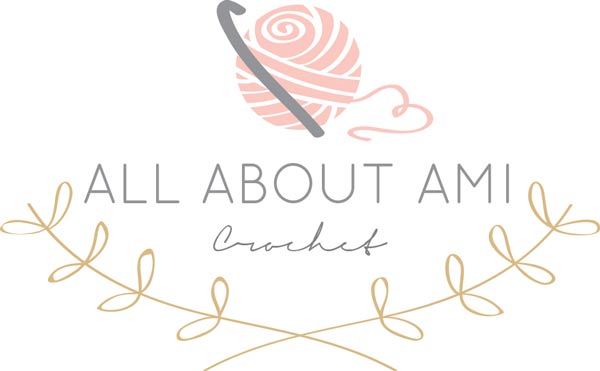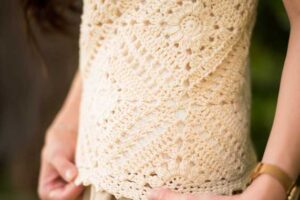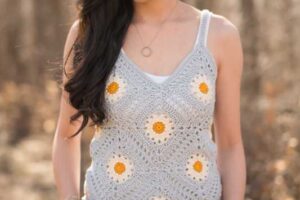***You can purchase an INEXPENSIVE AD-FREE PDF of this pattern on Etsy HERE , Ravelry HERE and on LoveCrafts HERE! This beautifully formatted PDF includes ALL the step-by-step pictures and pattern and is a total of 13 pages including the cover page! Lion Brand Yarn has made a convenient kit HERE that includes the pattern and all the 24/7 Cotton yarn needed to crochet this stunning tote bag!
***The step-by-step tutorial has been divided into 2 parts- please reference the below blog posts for detailed photos and explanations:
- Part 1: Ovular Base, Half Double Crochet Side Panels & Accent Panels
- Part 2: Straps, Strap Edging and Detailing & Interior Pocket
***Join the Camellia Tote Bag Crochet-Along HERE! Add this design to your Ravelry queue HERE!
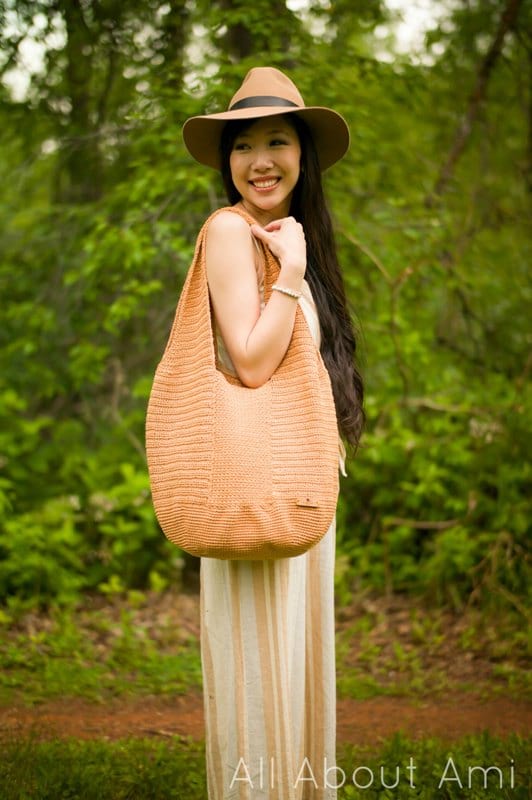
Pattern Description: Crochet this gorgeous Camellia Tote Bag that has a sturdy and unique construction using a variety of stitches with thick and comfortable straps. This project is fun to work up as it is segmented into various sections using strong mercerized 24/7 Cotton. Personalize the middle accent panel found in the center of the bag using your favourite stitch! You will love carrying this modern and sleek bag to tote around your important items wherever you go!
Skill Level: Level 2 – Easy
Materials:
- 6 skeins of 24/7 Cotton (worsted weight level 4 yarn – color shown in sample is “Camel”); ~520 grams or 970 yards used – purchase the Lion Brand Yarn kit HERE
- 2 mm, 2.75 mm, and 3.5 mm Clover Amour crochet hooks
- Yarn Needle (bent tip helpful for attaching)
- Lock ring stitch markers
- Steamer (optional for blocking pocket- I use this affordable one HERE)
- Tags (optional – mine are by BrickBubble) and embroidery floss for attaching tags; I used a wood tag for the front of the bag and a faux leather square garment tag for the interior pocket
- Large size Periea purse organizer (optional) to place inside bag to add more pockets and zipper closure
Gauge: 23 sts and 13.5 rows = 4”/10 cm (half double crochet worked with 2 mm hook in turned rows)
Dimensions: Height: 24”/61 cm, Width: 17.5”/44 cm, Straps: 14”/36 cm
Abbreviations:
- Half Double Crochet Decrease (Hdc dec): Yarn over, insert crochet hook into next stitch. Yarn over and pull up a loop (3 sts on hook). Insert crochet hook into next st. YO and pull up a loop (4 sts left). Yarn over one last time and pull through all remaining loops on hook.
- Increase (Inc): Work 2 single crochets in the next stitch to increase the stitch count from 1 to 2. These increases are only found in the ovular base section.
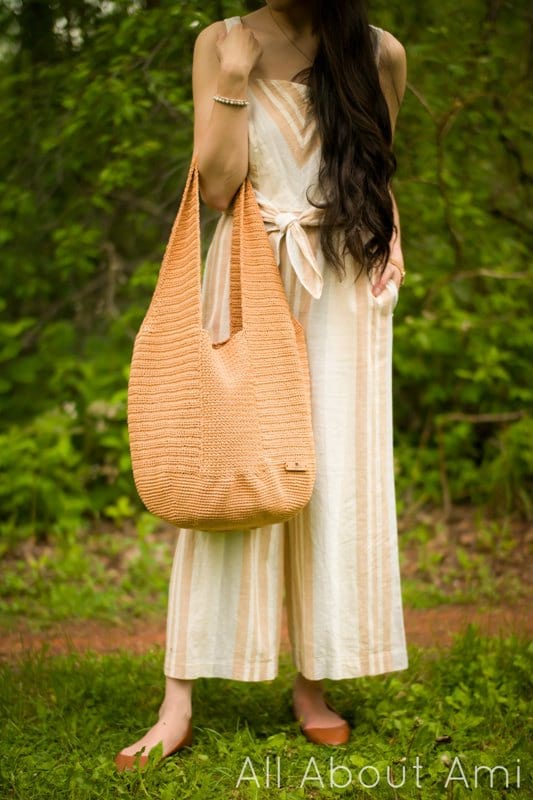
Notes:
- This bag is constructed in various segments using a variety of stitches with different crochet hooks – please take note of which crochet hook size is used for each section.
- An ovular base is first crocheted in continuous (unjoined) rounds using single crochet stitches. I recommend using a stitch marker to help keep your place and mark the end of each round – take special note of where the increases are located.
- After the last round of the base is crocheted, the stitches are split up into 4 different sections that will become: 2 Half Double Crochet Side Panels (form the sides of the bag) and 2 Middle Accent Panels (panels found directly in the middle of the front and back of the bag where you can choose any stitch for your accent).
- The Half Double Crochet Side Panels are crocheted in turned rows using a small hook to get tight and dense stitches (to prevent further stretch). If a larger hook is used, you can keep building up the rows until the desired height is achieved.
- Next, the 2 Middle Accent Panels are crocheted in turned rows. Stitches are picked up along the base between where the Half Double Crochet Side Panels were crocheted. I used the “Single Crochet Columns” stitch (a dense stitch is recommended if you do not want small items to fall through the holes of your bag).
- Once the heights of the panels match, the sides of the Middle Accent Panels are whip stitched to the sides of the Half Double Crochet Panels.
- Each Half Double Crochet Side Panel is split into two to become the bag handles (in total, there will be 4 handle panels). The bag handles slowly taper and decrease towards the top – the decreases are all worked on one side. The handles use the half double crochet stitch worked in turned rows. Rows can be removed or added to shorten or lengthen the handles based on your height and where you want the bag to hang when wearing it.
- The tops of the handles are slip stitched together to become two handles (they should frame the Accent Panels).
- To provide more strength to the handles and to add a clean edging, slip stitches are worked around the entire borders of the handles and the accent panels.
- The tops of the handles are then folded inwards and seamed together to form a tube that provides more strength as well as a beautiful ruched effect.
- A interior pocket is crocheted using the stitch used for the accent panel (for example, Single Crochet Columns) and whip stitched to the inner back panel of the bag. You can size the pocket to fit various items (e.g. I sized the pocket to fit my cell phone).
- I highly recommend purchasing a purse organizer that you can insert into your crochet bags. They are lightweight inserts that come with many different pockets and zipper closure so that you can keep your items organized and easy to access. My Periea purse organizer that fits perfectly into the Camellia Tote Bag is a large size with the dimensions of 8.1”/20.6 cm (height), 13.2”/33.5 cm (length), and 7”/17.8 cm (depth).
- Note that the right side of the ovular base should be facing down or outwards when your tote bag is complete (the wrong side should be on the inside of the bag).
Note: Watch this video below to see how this project can be segmented into 4 sections (Ovular Base, Half Double Crochet Side Panels, Accent Panels & Straps and Interior Pocket) with a detailed verbal explanation of each part. These videos were recorded for the Camellia Tote Bag Crochet-Along:
PATTERN INSTRUCTIONS

***Please reference Part 1 of the step-by-step tutorial HERE to see detailed photos of the making of the Ovular Base, Half Double Crochet Side Panels & Accent Panels.
- Ovular Base
Using 3.5 mm hook,
Chain 16 (this is the foundation chain)
R1: Starting from second chain from hook, Sc 15 in back loops of foundation chain. Turn and Sc 15 in front loops of the foundation chain [we are making an oval by crocheting around the chain – see tutorial on how to do this HERE]. (30 sts)
R2: *Inc*, rep 2 times. *Sc 2, Inc*, rep 3 times. Sc 2. *Inc*, rep 4 times. *Sc 2, Inc*, rep 3 times. Sc 2. *Inc*, rep 2 times. (44)
R3: Sc 44.
R4: Sc 2, Inc, Sc 18, Inc. Sc 2, Inc, Sc 18, Inc. (48)
R5: Sc 3, Inc, Sc 18, Inc. Sc 4, Inc, Sc 18, Inc, Sc 1. (52)
R6: Sc 3, Inc, Sc 20, Inc. Sc 4, Inc, Sc 20, Inc, Sc 1. (56)
R7: *Sc 6, Inc*, rep 8 times. (64)
R8: *Sc 7, Inc*, rep 8 times. (72)
R9: *Sc 8, Inc*, rep 8 times. (80)
R10: *Sc 9, Inc*, rep 8 times. (88)
R11: Sc 9, Inc, Sc 26, Inc. Sc 16, Inc, Sc 26, Inc, Sc 7. (92)
R12: Sc 4, Inc, Sc 3, Inc, Sc 30, Inc. Sc 3, Inc, Sc 6, Inc, Sc 3, Inc. Sc 30, Inc, Sc 3, Inc, Sc 2. (100)
R13: Sc, Inc. *Sc 5, Inc*, rep 2 times. Sc 25, Inc. *Sc 5, Inc*, rep 4 times. Sc 25, Inc, Sc 5, Inc, Sc 4. (110)
R14: Sc 7, Inc. *Sc 4, Inc*, rep 2 times. Sc 23, Inc. *Sc 4, Inc*, rep 2 times. Sc 10, Inc. *Sc 4, Inc*, rep 2 times. Sc 23, Inc. *Sc 4, Inc*, rep 2 times. Sc 3. (122)
R15: Sc 2, Inc. *Sc 5, Inc*, rep 3 times. Sc 24, Inc. *Sc 5, Inc*, rep 6 times. Sc 24, Inc. *Sc 5, Inc*, rep 2 times. Sc 3. (136)
R16: Sc 136.
R17: Sc 9, Inc, Sc 10, Inc. Sc 32, Inc, Sc 10, Inc. Sc 12, Inc, Sc 10, Inc. Sc 32, Inc, Sc 10, Inc, Sc 3. (144)
R18: Sc 144.
R19: Sc 10, Inc, Sc 7, Inc. Sc 40, Inc, Sc 7, Inc. Sc 14, Inc, Sc 7, Inc. Sc 40, Inc, Sc 7, Inc, Sc 4. (152)
R20: Sc 152.
R21: Sc 6, Inc, Sc 11, Inc. Sc 44, Inc, Sc 11, Inc. Sc 6, Inc, Sc 11, Inc. Sc 44, Inc, Sc 11, Inc. (160)
R22: Sc 160.
R23: Sc 3, Inc, Sc 8, Inc. Sc 9, Inc, Sc 41, Inc. Sc 9, Inc, Sc 8, Inc. Sc 8, Inc, Sc 9, Inc. Sc 41, Inc, Sc 9, Inc, Sc 5. (170)
R24: Sc 170.
R25: Sc 10, Inc, Sc 12, Inc, Sc 45, Inc. *Sc 12, Inc*, rep 3 times. Sc 45, Inc, Sc 12, Inc, Sc 2. (178)
R26: Sc 178.
R27: Sc 9, Inc, Sc 11, Inc. Sc 53, Inc, Sc 11, Inc. Sc 10, Inc, Sc 11, Inc. Sc 53, Inc, Sc 11, Inc, Sc 1. (186)
R28: Sc 186.
R29: *Sc 14, Inc*, rep 2 times. Sc 45, Inc, Sc 14, Inc. Sc 16, Inc, Sc 14, Inc. Sc 45, Inc, Sc 14, Inc, Sc 2. (194)
R30: Sc 194.
R31: Sc 13, Inc, Sc 14, Inc. Sc 49, Inc, Sc 14, Inc. Sc 16, Inc, Sc 14, Inc. Sc 49, Inc, Sc 14, Inc, Sc 3. (202)
For this next and last round of the ovular base, you will NOT be crocheting around the entire round to work all the stitches – you will stop part way and begin working the Half Double Crochet Side Panel.
R32: Sc 171 (note that 31 stitches are left unworked). DO NOT CUT THE YARN (this will be used to crochet the Half Double Crochet Side Panel in the next section). Place a stitch marker in the next stitch (this will be point D in the diagram shown in the next section).
Approximate measurements of base: 15.75”/40 cm at widest point x 12.5”/32 cm at narrowest point
Using stitch markers (indicated by A, B, C and D), divide up the ovular base into 4 sections so that there are 70 stitches on two sides and 29 stitches on the other two sides (the 4 stitch markers are 4 stitches as well). 70 + 70 + 29 + 29 + 4 = 202. You have placed your first stitch marker at D (the stitch next to the last stitch of Round 32 of the ovular base) and you can count around to place the rest of the stitch markers. Reference the diagram below that shows the stitch breakdown and where to place the stitch markers when the right side of the ovular base is facing you (the right side will eventually be the outside/bottom of the tote bag). The 4 stitch marker stitches will be used in both the Half Double Crochet Side Panels AND Middle Accent Panels.
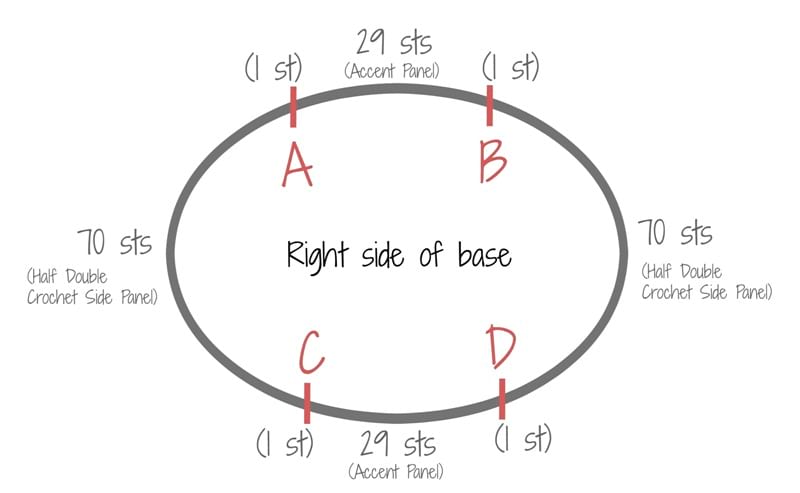
Stitch Number Overview:
– Half Double Crochet Side Panels = 72 stitches (70 + 1 + 1)
– Accent Panels = 31 stitches (29 + 1 + 1)
- Half Double Crochet Side Panels (make 2) – worked in turned rows
Using 2 mm hook,
First side:
Starting from where we left the yarn in the ovular base (first stitch will be D in diagram) and continuing to work in the same direction to continue that round towards B:
Row 1: Hdc 72.
Row 2: Chain 2, turn (the chain 2 does not count as a stitch). Hdc in same stitch and in each st across. (72).
R3-33: Repeat Row 2 or until this half double crochet section reaches 9.75”/25 cm in height.
Do not cut the yarn as we can use this yarn to continue working the straps later on. If adjusting the number of rows, use an odd number of rows so the yarn ends up on the far left side of the Half Double Crochet Side Panel.
Second side:
Row 1: Rejoin yarn at A. To do so, make a slip knot. Insert your crochet hook into stitch A. Add the slip knot and pull through. Chain 2. Insert your hook into same stitch and work 1 hdc (the chain 2 does not count as a stitch). Hdc 71 across the rest of the stitches towards C. (72)
Row 2: Chain 2, turn. (the chain 2 does not count as a stitch). Hdc in same stitch and in each st across. (72).
R3-33: Repeat Row 2 or until this half double crochet section reaches 9.75”/25 cm in height/matches the first side. Do not cut the yarn as we can use this yarn to continue working the straps later on.
Note that the stitches indicated by the stitch markers (A, B, C and D) will be included in BOTH the Half Double Crochet Sides AND Accent Panels.
- Accent Panels (make 2)
We will now be working the accent panels in turned rows by crocheting in the gap left by the Half Double Crochet Sides. There should be a gap of 29 stitches. If we include the stitch marker stitches (where the Half Double Crochet Side Panels were worked too), we will have a total of 31 stitches comprising the Accent Panels.
Using 2.75 mm hook,
Row 1: Rejoin yarn at B. To do so, make a slip knot. Insert your crochet hook into stitch B. Add the slip knot and pull through. Chain 1, work single crochet in same stitch. *Chain 1, skip 1, sc 1*, across (last stitch should be a Single Crochet at A). (31 sts, or 16 single crochets and 15 chain 1’s in between).
Row 2: Chain 1, turn. Work 1 sc in second st from hook (this is the sc from row below). *Chain 1, skip 1, sc 1* across (the single crochets should stack upon each other and the chain 1 gaps should stack upon each other). (31)
R3-53: Repeat Row 2 or until this accent panel reaches 9.75”/25 cm in height (matches height of Half Double Crochet Side Panels).
Fasten off and leave long end for sewing. For the second side, repeat the same instructions above, rejoining the yarn at C and heading towards D.
Using a yarn needle, whip stitch the sides of the Accent Panels to the sides of the Half Double Crochet Side Panels. I like to have the wrong sides facing me when I whip stitch pieces together so that the seam is less visible on the right side. Ensure the right side of the ovular base is now facing downwards/on the outside of the bag while the wrong side is on the inside.
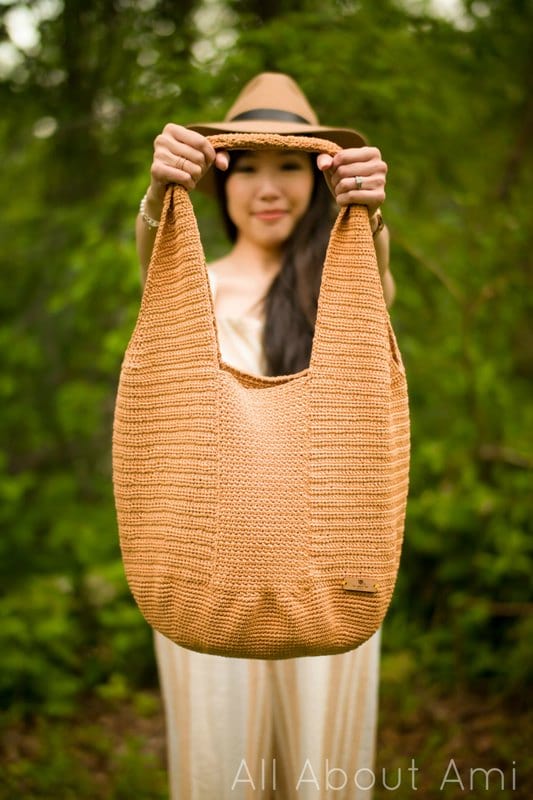
***Please reference Part 2 of the step-by-step tutorial HERE to see detailed photos of the making of the Straps, Strap Edging and Detailing, & Interior Pocket.
- Strap Panels (make 4)
We will now be working the strap panels that emerge from the Half Double Crochet Side Panels in turned rows. Divide the Half Double Crochet Side Panel in half (72 stitches total) and place two stitch markers at the 36th and 37th stitch to indicate where this panel will split into two (Left Strap Panel and Right Strap Panel). Both panels will have a curved shape as they emerge from the center, meaning that the decreases are worked on the side facing the center. Remember that when working the first half double crochet of a row, work it in the same stitch where you worked the Chain 2, since the Chain 2 does not count as a stitch (this is particularly important to remember when the half double crochet decreases are at the beginning of the row). We will start with 36 stitches and gradually decrease to 8 stitches by the end. We will be using a 2 mm hook for all the strap panels.
We will begin by working the Left Strap Panel and continuing to work where you left off at the last row of the Half Double Crochet Side Panel.
Row 1: Chain 2, turn (heading towards midpoint). Hdc in same stitch and in each st across until 36 stitches have been worked (this should take you to the stitch marker that you placed). (36)
R2: Chain 2, turn. *Hdc dec*, rep 6 times. Hdc across. (30)
R3: Chain 2, turn. Hdc in same stitch and in each st across. (30)
R4: Chain 2, turn. *Hdc dec*, rep 4 times. Hdc across. (26)
R5: Chain 2, turn. Hdc in same stitch and in each st across. (26)
R6: Chain 2, turn. *Hdc dec*, rep 2 times. Hdc across. (24)
R7: Chain 2, turn. Hdc in same stitch and in each st across. (24)
R8: Chain 2, turn. *Hdc dec*, rep 2 times. Hdc across. (22)
R9: Chain 2, turn. Hdc in same stitch and in each st across. (22)
R10: Chain 2, turn. Hdc dec, Hdc across. (21)
R11: Chain 2, turn. Hdc in same stitch and in each st across. (21)
R12: Chain 2, turn. Hdc dec, Hdc across. (20)
R13: Chain 2, turn. Hdc in same stitch and in each st across. (20)
R14: Chain 2, turn. Hdc dec, Hdc across. (19)
R15: Chain 2, turn. Hdc in same stitch and in each st across. (19)
R16: Chain 2, turn. Hdc dec, Hdc across. (18)
R17: Chain 2, turn. Hdc in same stitch and in each st across. (18)
R18: Chain 2, turn. Hdc dec, Hdc across. (17)
R19: Chain 2, turn. Hdc in same stitch and in each st across. (17)
R20: Chain 2, turn. Hdc dec, Hdc across. (16)
R21: Chain 2, turn. Hdc in same stitch and in each st across. (16)
R22: Chain 2, turn. Hdc dec, Hdc across. (15)
R23: Chain 2, turn. Hdc in same stitch and in each st across. (15)
R24: Chain 2, turn. Hdc dec, Hdc across. (14)
R25: Chain 2, turn. Hdc in same stitch and in each st across. (14)
R26: Chain 2, turn. Hdc dec, Hdc across. (13)
R27: Chain 2, turn. Hdc in same stitch and in each st across. (13)
R28: Chain 2, turn. Hdc dec, Hdc across. (12)
R29: Chain 2, turn. Hdc in same stitch and in each st across. (12)
R30: Chain 2, turn. Hdc dec, Hdc across. (11)
R31: Chain 2, turn. Hdc in same stitch and in each st across. (11)
R32: Chain 2, turn. Hdc dec, Hdc across. (10)
R33: Chain 2, turn. Hdc in same stitch and in each st across. (10)
R34: Chain 2, turn. Hdc dec, Hdc across. (9)
R35: Chain 2, turn. Hdc in same stitch and in each st across. (9)
R36: Chain 2, turn. Hdc dec, Hdc across. (8)
R37-44: Chain 2, turn. Hdc in same stitch and in each st across. (8).
If you would like to adjust the length of the handles depending on your height (I am 5’6 for reference) and where you want the bag to hang, increase or decrease the number of rows between R37-44 where there are no decreases as you are repeating 8 half double crochets row by row for that section. Use an even number of rows.
After finishing Row 44, you can cut the yarn after completing the Left Strap Panels.
Right Strap Panel
With the right side of the Half Double Crochet Side Panel facing you, rejoin the yarn at the far right corner . To do so, make a slip knot. Insert your crochet hook into the designated stitch. Repeat the exact same pattern as worked for the Left Strap Panel from Rows 1-44. Note that for Row 1 you do not need to turn your work, and the end of Row 1 should take you to the second stitch marker that you placed (the midpoint of the Half Double Crochet Side Panel). The curved decrease should be a mirror image of the Left Strap Panel so that the two curved edges are facing each other. For the Right Strap Panels, DO NOT CUT THE YARN, as you can use this yarn to slip stitch the strap panels together (the Left Strap Panel emerging from one Half Double Crochet Side Panel will be slip stitched to the Right Strap Panel emerging from the opposite Half Double Crochet Side Panel).
Repeat the entire process to create the Left Strap Panel and the Right Strap Panel for the other side of the bag.
Joining of Straps
Once all 4 strap panels have been crocheted, it is time to join the straps together. The Left Strap Panel emerging from one Half Double Crochet Side Panel will be joined to the Right Strap Panel emerging from the opposite Half Double Crochet Side Panel. The joined straps should frame the Accent Panel (be sure you are joining the correct straps). Using the yarn that you left from the Right Strap Panel, slip stitch the 8 stitches of one strap panel to the 8 stitches of the other strap panel, going through the front and back loops of all stitches. Fasten off the yarn from one strap joining but LEAVE YARN FROM THE OTHER STRAP JOINING to continue crocheting the strap edging of the large section (described in the next part).
Strap Edging
To strengthen the straps and add a smooth decorative edge, we will be working slip stitches around all the straps using a 2 mm hook. There will be 3 sections that need the slip stitch edging: 2 smaller sections that go across the straight edges of the strap panels with the bottom as the Accent Panel, and 1 larger section that goes around the curved edges of the strap panel).
For the larger section, continue using the yarn that you left after joining the straps. Carefully slip stitch around the described area. To do so, insert your hook into the next space, yarn over, and pull through both loops. Continue in this manner around until you reach the first slip stitch you created. Slip stitch to the first slip stitch created and fasten off the yarn.
For the two smaller sections, rejoin the yarn at any point around the described area (I rejoined the yarn along the strap panel). Work slip stitches all the way around, slip stitch to the first slip stitch created and fasten off the yarn.
Strap Tube Detail
To strengthen the straps even more and provide a beautiful detail, we will seam the top of the straps into a tube. With the outside of the bag facing you, measure 4.5”/11 cm across the tops of the handles (you can use stitch markers to indicate this length). Pinch the strap in on itself by folding the strap inwards towards the center. Note that with the front side of the strap facing you (back side is on the inside of the bag), the front sides will be pinched together and form the inside of the tube. Using a yarn needle and a 35”/89 cm yarn tail, start in the middle (leave half the length for each side) and whip stitch outer edges together by going through the outermost loops on either side to form a tube. Once each end has been reached, whip stitch back towards the middle for added strength (both yarn ends should meet back at the center). Tie both yarn ends into sturdy knots and weave in the ends. Hide all ends into this tube that has been formed.
- Interior Pocket:
Using 2.75 mm hook,
Chain 42
Row 1: Starting in second st from hook, sc 1. *Chain 1, skip 1, sc 1* across. (41 sts, or 21 single crochets and 20 chain 1’s in between).
Row 2: Chain 1, turn. Work 1 sc in second st from hook (this is the sc from row below). *Chain 1, skip 1, sc 1* across (the single crochets should stack upon each other and the chain 1 gaps should stack upon each other). (41)
Row 3-39: Repeat Row 2
A rectangle has been created. Chain 1 and slip stitch down one side, across the bottom, and up the other side to smooth the edges. Fasten off and leave long tail for sewing. Block pocket if necessary to flatten it. Optional: Sew square garment tag onto pocket with embroidery floss.
Use the whip stitch to attach the pocket to the interior back of the bag, going through the outermost loops of the slip stitch edging and being careful not to go through the entire panel of the bag (otherwise the whip stitches will be visible from the outside). I positioned the bottom of my pocket right where the ovular base transitions to the half double crochet side panels/accent panels.
Note that I sized this pocket to fit my cell phone. You can adjust your initial number of stitches and the number of rows to fit your cell phone. The gauge for the pocket using Single Crochet Columns is: 27 sts and 23 rows = 4”/10 cm.
Final dimensions of my pocket: 6.25”/15 cm across, 7”/18 cm long
Optional: Attach wood garment tag to front of tote bag in bottom right corner using embroidery floss (you can add a pop of colour by choosing a brighter embroidery floss colour).
Optional: Insert large Periea purse organizer into Camellia Tote Bag to add compartments and zipper closure!
***If you would like to view this pattern in Portuguese, please click HERE. Thank you to Bruna Scopel of Crochet Land for the translation!
*****************************
The Camellia Tote Bag is such a stylish way to tote around your items! It is the epitome of sophistication and elegance, and it is incredibly sturdy using strong mercerized 24/7 Cotton yarn!

I love experimenting with different stitches and textures as they provide so much visual interest when combined together. The Accent Panels in the center are a great way for you to show off your favourite stitch and personalize the bag to really make it your own! Bags are one of my favourite items to crochet and design as it is so exciting working on the different sections and seeing it all come together in a functional item that you can use all the time. I know I will get a lot of use out of this Camellia Tote Bag, and adding the insert with the compartments and zipper closure allows this tote bag to become your everyday bag!
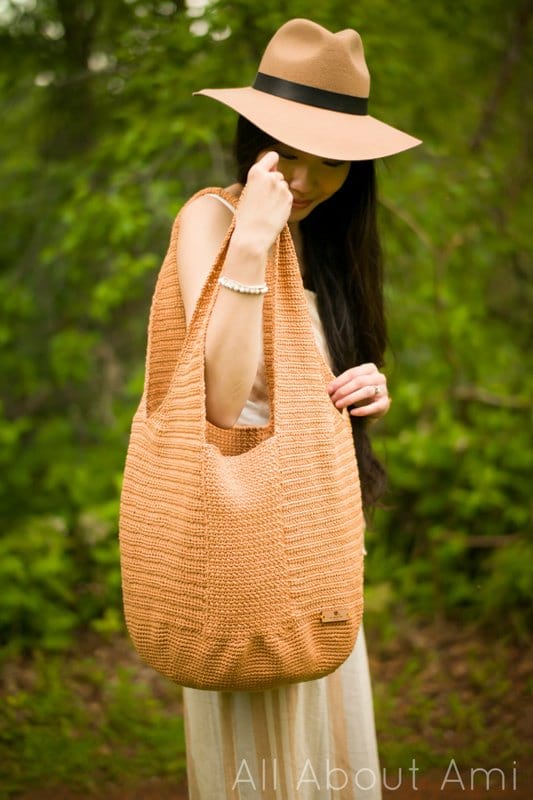
In case you are curious why I named this bag “The Camellia Tote Bag“, we watched a K-Drama on Netflix called “When the Camellia Blooms” a while back. The main character Dongbaek frequently wore crocheted hats and carried crocheted purses, and I thought “Camellia” had such a pretty ring to it. Furthermore, I used the colourway called “Camel” of 24/7 Cotton, so I thought this would be the perfect name for this sturdy tote bag!
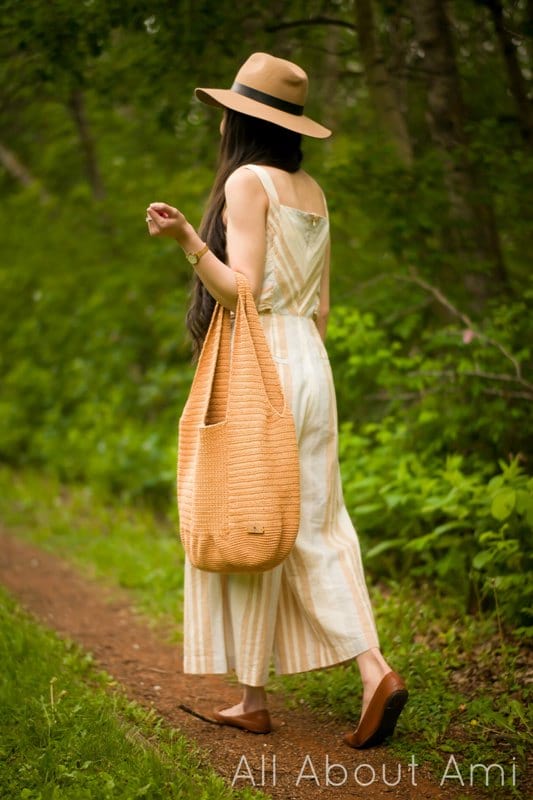
I am so proud of this design, and I cannot wait to see all of your finished Camellia Tote Bags as well! Once again, do not forget to reference Part 1 and Part 2 of the step-by-step tutorial, and you can also purchase a concise, beautifully-formatted PDF HERE that contains the entire pattern as well as all the step-by-step photos (easy to print and save). The Lion Brand Yarn Kit containing all the 24/7 Cotton yarn you need (choose any colour you want with 24 different shades available) to make the Camellia Tote Bag can be found HERE! Lastly, you can subscribe to my e-mail newsletter HERE if you would like to get updates about all my designs and projects straight to your inbox. Thank you for all the love you have shown this design already – happy crocheting, everyone!

{This post is sponsored by Lion Brand Yarn! I’ve loved working with their yarn throughout the years and I’m thrilled that I get to collaborate with them every month!}
This pattern is an original pattern by Stephanie Lau of All About Ami. Please do not claim this pattern as your own. If you wish to share this pattern, you may link to this pattern but please do not reprint it on your site. You may keep a copy for your own personal use but please DO NOT sell the pattern or distribute it.
You may sell products made from this pattern but please clearly credit the design to me, Stephanie Lau of All About Ami, and provide a link to my blog www.AllAboutAmi.com. Permission is NOT granted for mass production or factory manufacturing of any kind. Thank you for being respectful and for your understanding!
